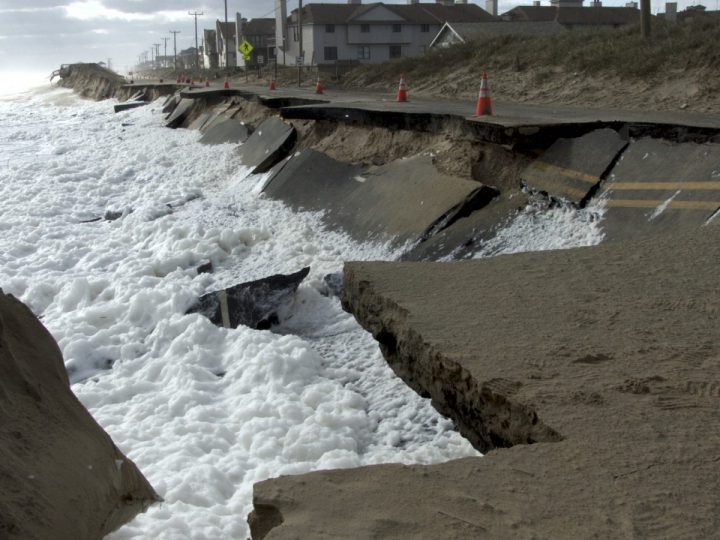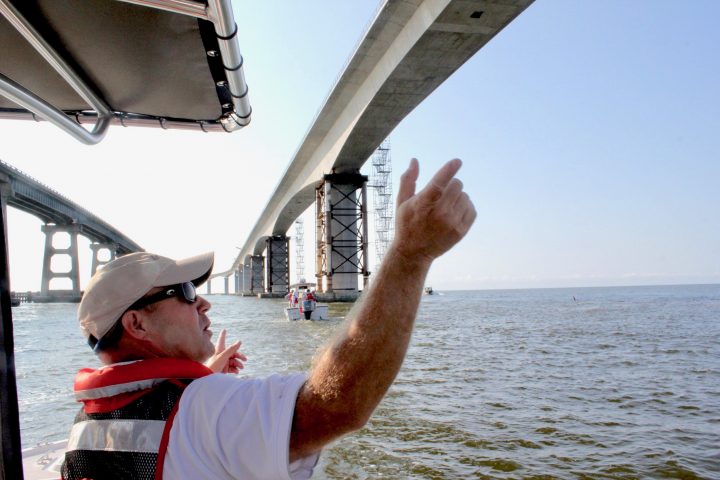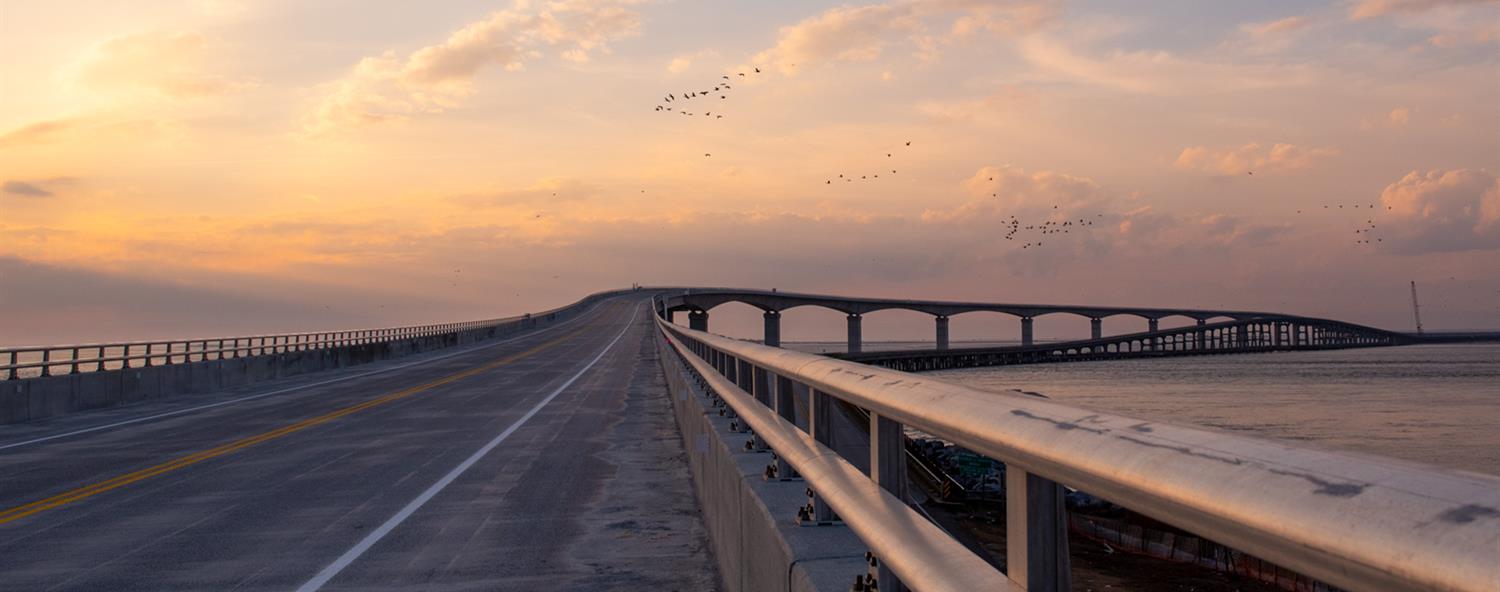
This is the fifth installment in a continuing series on climate change and the North Carolina coast that is part of the Pulitzer Center’s nationwide Connected Coastlines reporting initiative.
Twenty-seven years ago, an interagency panel of bureaucrats, politicians and scientists gathered for the first time in Atlanta, Georgia, to study how to save a North Carolina coastal highway skirting the volatile waters of the Graveyard of the Atlantic.
Supporter Spotlight
No one back then talked about resilience or adaptation, and certainly not retreat. Still, the diverse group turned out to be pioneers of brainstorming and collaborating to solve the multitude of challenges from sea level rise and other climate change impacts.
The Outer Banks Task Force met six times before being shelved after one year for lack of funds and staff. But that was only one iteration of numerous transportation study groups that assembled over the years to address N.C. 12, a sliver of roadway stretching about 65 miles on Hatteras and Ocracoke islands.The two-lane road has been a headache for the state practically from the day the first tire hit the pavement. In 1962, the infamous Ash Wednesday Storm ripped open an inlet in Buxton and destroyed 25% of the dunes that buffered the road from ocean waves.
Still, the extreme and worsening coastal conditions for N.C. 12 serve as both lesson plan and cautionary tale for teams like the Outer Banks Task Force, working against time while begging for funds to maintain vital transportation infrastructure into the future.
Gov. Roy Cooper’s executive order in 2018 directed 10 cabinet agencies and the state Department of Agriculture and Consumer Services to “integrate climate adaptation and resiliency planning into their policies, programs and operations.” In response, the North Carolina Office of Recovery and Resiliency was created to coordinate agencies and assist communities facing storm recovery and/or risks of future climate change impacts.
Supporter Spotlight
But complex problems that involve many players, a slew of stakeholders and tons of money can become unwieldy — and paralyzing.
At least 10 government entities — federal, state and local — were represented on the task force, in addition to several coastal engineers and scientists from different universities.
“How do we simplify what we’re trying to do so that we get something done?” former Dare County Board of Commissioners Chairwoman Geneva Perry asked the revived task force in November 1998, as quoted then in The Virginian-Pilot. “This thing has been going on forever, and unless we keep kicking it, it dies again.”
Built in phases during the 1950s, N.C. 12 bisects Cape Hatteras National Seashore, Pea Island National Wildlife Refuge and seven villages. It is also the only route for millions of tourists that contribute to the Outer Banks’ $1 billion tourism economy.

The roadway, with the Atlantic Ocean on one side and the massive Pamlico Sound on the other, is inches above mean sea level and crosses numerous weak spots on skinny barrier islands that are subject to severe beach erosion. To add to its vulnerabilities, the islands are close to the warm waters of the Gulf Stream, the “super-highway” for Atlantic hurricanes.
Over the decades, the road has been repeatedly over-washed by ocean and sound tide; undermined by ocean surge; inundated by moon tide and rain deluges; buried by mountains of sand from storm-flattened dunes; broken apart by hurricanes and nor-easters; and covered by telephone poles, trees and debris from destroyed buildings.
Sections of road have been replaced, elevated, bridged or moved further from the ocean. Adjacent beaches have been widened and walkways have been built to protect dunes.
And the dunes between the beach and the road have been built, knocked down and rebuilt, higher, longer and stronger. Then flattened again.

“It’s a very good example of a corridor being impacted by climate,” Jerry Jennings, Division 1 engineer with the North Carolina Department of Transportation, said in a recent telephone interview. “Certainly, from Division 1’s perspective, there’s not another road that has the challenges that N.C. 12 has.”
Located in the northeast corner of North Carolina, Division 1 is a huge, mostly rural territory that encompasses 14 counties. It not only includes the second-largest estuarine system in the nation, its coastal area — the Outer Banks — is one of the most vulnerable regions in the U.S. to the impacts of sea level rise.
Maintenance and repair of the road from Oregon Inlet to Ocracoke village has cost NCDOT about $75 million in the last 10 years, not including N.C. 12 improvements that were part of the recently completed Bonner Bridge replacement project.
Opened last year, the new Marc Basnight Bridge spans the inlet and incorporates phased work on the road to just south of Rodanthe.
The only other comparison in the state to N.C. 12 cited by some transportation officials could be the heavily traveled Blue Ridge Parkway in the mountains, which is subject to costly landslides and intense winter weather.
But a lot of environmental changes generally have been observed over time in coastal regions and in low-lying areas, Jennings said. Shoreline erosion along water bodies, for example, can impact roadway shoulders and potentially threaten the road. Flooding is a persistent problem on roads in Mackey’s Island, Aydlett and Water Lily in Currituck County and on N.C. 94 at Lake Mattamuskeet in Hyde County.
“There’s a number of those out there,” he said. “It’s not just a beach thing.”
An ongoing improvement project on Colington Road in Kill Devil Hills includes elevation of parts of the road vulnerable to tidal flooding, he said, “which seems to be a longstanding problem.”
“That project will attempt to resolve that,” Jennings said. “It’s hard to say what is directly related to climate change.”
NCDOT had been working with the new North Carolina Office of Recovery and Resiliency, or NCORR. But NCDOT’s resiliency work has been suspended indefinitely while the agency addresses severe budgetary shortfalls aggravated by COVID-19 shutdowns.
Unspecified cuts are also expected in NCDOT’s Ferry Division, which operates about 20 ferries on seven regular routes on the coast. The passenger ferry between Hatteras and Ocracoke islands has been canceled for the season.
In March, North Carolina Institute for Climate Studies released the North Carolina Climate Science Report, an assessment of current and projected climate impacts to the state. The report is a component of the comprehensive N.C. Risk Assessment and Resilience Plan that is expected to be completed this summer.
The report found that future impacts in the state from climate change — some effects are already apparent — will likely be more intense storms, increased rain volume, more wildfires and drought, more hot days and higher humidity, increased flooding — including sunny day tide — and higher sea levels, especially on the northeast coast.
“For transportation, it means offering people multiple ways to get around, by better connecting roads and sidewalks and providing quality transit services,” the report said.
Jessica Whitehead, chief resilience officer with NCORR, said that NCDOT has been an engaged participant in discussions about such critical needs as building redundancy and updating old infrastructure.

Even with NCDOT’s and other state agencies’ budgetary woes from the pandemic, Whitehead said that resiliency work will continue.
“The thing about climate change in any of this, it’s not going to go away,” she said. “We’re still going to figure out ways to plan for it.”
Transportation projects in North Carolina have already been engineered for environmental changes, said Chris Werner, director of technical services at NCDOT.
“Resiliency is a critical part of how we design and build our infrastructure,” he said. “We work with all our partners across the state.”
Werner said that the agency has an inbuilt culture that fosters innovative and proactive approaches to problem solving.
“We’re always looking for cutting-edge analytics and software,” he said. “Most of us are engineers. The more data we can get, the more analytics we can perform.”
One example is application of the state’s data-rich Flood Inundation Mapping Alert Network, or FIMAN, to not only predict flooding on roads and bridges, but also to design for it by looking at trends in the data.
The agency, he said, is in the process of expanding the FIMAN gauge system from a property-impact focus to provide data specific to transportation infrastructure. For instance, data collection can be tailored so it can be used to prevent future road washouts.
It’s not just a matter of fixing a damaged structure, he explained, the goal is to keep it from happening again by building redundancy and resiliency.
When severe flooding on U.S. 421 in Wilmington in 2018 during Hurricane Florence damaged the road and cut off traffic, Werner said, the agency took the opportunity to “build better and stronger.” After analysis of historic and current data, instead of just replacing ruined culverts, the department replaced them with a new bridge. Another bridge was also built nearby, providing the transportation corridor with both redundancy and resiliency in the event of future flooding.
“Our goal is to build infrastructure that’s durable and safe and resilient as possible,” Werner said. “As civil engineers, we’re constantly improving what we’ve done in the past. That’s what we do. It all stems from field observation and data.”
Other measures NCDOT has put in place, he said, are monitors of water levels at low bridges, and identifying alternative travel routes on its READY NC app. The department has partnered with Google Maps and WAZE to feed their traffic data into the app. Also, DRIVENC.gov shows up-to-date closures and maintenance work on the state’s roads.
In reality, the feats of engineering for NCDOT are not so much in dramatic crane work at bridge construction sites or road restorations after storms. It’s mostly what goes on behind the scene at research centers and laboratories.
“We do a lot of work with our universities,” said Neil Mastin, NCDOT Research and Development manager. “We work with business units and academics.”
In May 2019, the department presented its first Research & Innovation Summit at North Carolina Agricultural and Technical State University to discuss transportation-related innovations and research.
Although it is not often a focus of public discussion, NCDOT has been studying numerous issues that could result in transportation improvements, although its research program for 2021 has been postponed, Mastin said.
Ongoing or planned research projects include the following:
- How to reduce environmental impacts of road construction.
- Building 2-D scour models to improve understanding of water interaction at bridge pilings.
- Monitoring erosion on the Outer Banks going back 20 years, along with an ongoing coastal monitoring program, that gathers data on island width, the size of the dunes and distance of the road to the ocean.
- Documenting stormwater impacts from recent storms (on pause) and studying Neuse River watershed flood abatement study (ongoing).
- Forensic analysis of sections of girders from the old Bonner Bridge that spanned Oregon Inlet to learn how they withstood the harsh coastal conditions.
- Analysis of submerged aquatic vegetation in the Currituck Sound to understand where it is and how to protect it.
- Biologic stabilization of soil to potentially increase resistance to erosion.
- Using dredged material from the Rodanthe emergency ferry channel potentially to build bird or material disposal islands or to fill eroded areas.
Mastin said that NCDOT is also “hyper-aware” of the public concern about drainage issues. The state is responsible for the ditches and culverts within road right of ways, as well as the nine ocean outfalls in the state, all of which except one is on the Outer Banks.
“Water in general,” he said, “is the enemy of transportation networks.”
In the past, locations of all small and medium drainage pipes around the state were mapped, he added, with the ambitious goal — yet mostly unfulfilled — of eventually replacing them. But that’s just pipes — and flooding is getting increasingly worse.
“Eastern North Carolina in particular, with land as flat as it is, makes it extremely challenging,” Mastin said. “We can fix one problem somewhere and it makes it worse somewhere else.”
Drones are being used more often by NCDOT to provide footage of flooded areas and to help manage flood gates, he said. They’re also used to build wetlands, to identify plant types, to measure elevation and to help determine where to send crews after disasters. Researchers are also studying development of drones to inspect bridges.
Improvements of material — mostly concrete and asphalt — are constantly being studied, Mastin said. One example of research results is the proposed bridge replacement on Harkers Island, which would be the state’s first fully composite reinforced bridge. Rather than using corrosion-prone steel rebar, he said, the structure will be built with a mixture of carbon fiber prestressed strands and “fancy” fiberglass.
“We’ll be monitoring this closely,” he said. “This is really exciting.”

The new Marc Basnight Bridge over notoriously wild and wicked Oregon Inlet was designed to last 100 years and was built with high-performance, less-permeable concrete made to better endure corrosive salt air and water. It is the first bridge project in the state to use stainless reinforcing steel, and the bridge has longer and deeper pilings to withstand scour.
The Outer Banks Task Force, in a significant way, laid the groundwork for the bridge and the N.C. 12 improvements by determining where the problems were and what to do about them. Most importantly, the panel recognized the need for safety and access for both the bridge and the road and linked them together as a single corridor.
Jennings, the division engineer, said that over the last few years, feasibility studies have been completed looking at long-term options for eroded areas in Buxton, Hatteras and Ocracoke, as well as costs of the alternatives and how long projects would last.
Years before the panel was replaced by a “merger team” that worked on planning and permitting for the road and bridge projects, the Outer Banks Task Force had designated six vulnerable “hot spots” between Oregon Inlet and Ocracoke village that were critical to address, and started the planning process on each one.
Predictions about the dire risks at each of the hot spots – from storm surge, beach erosion, road loss, dune breaching, even another inlet cutting through – have since played out all too often.
In 1999, John Fisher, a N.C. State University civil engineer and then-chair of the task force science panel, called a reconstructed dune lost during Hurricane Dennis at the eroding Ocracoke hot spot a “Band-Aid” that wouldn’t last.
“We seriously think you should think about abandoning that whole stretch of road and relocating the ferry system,” he told the task force, according to The Virginian-Pilot on Nov. 7. “It didn’t make sense to us to try to maintain the highway.”
That is exactly what NCDOT is now considering. After storm after storm over the last 20 years wiped out dunes in the same hot spot, it seems Hurricane Dorian last September may end up taking that one off N.C. 12’s list.







